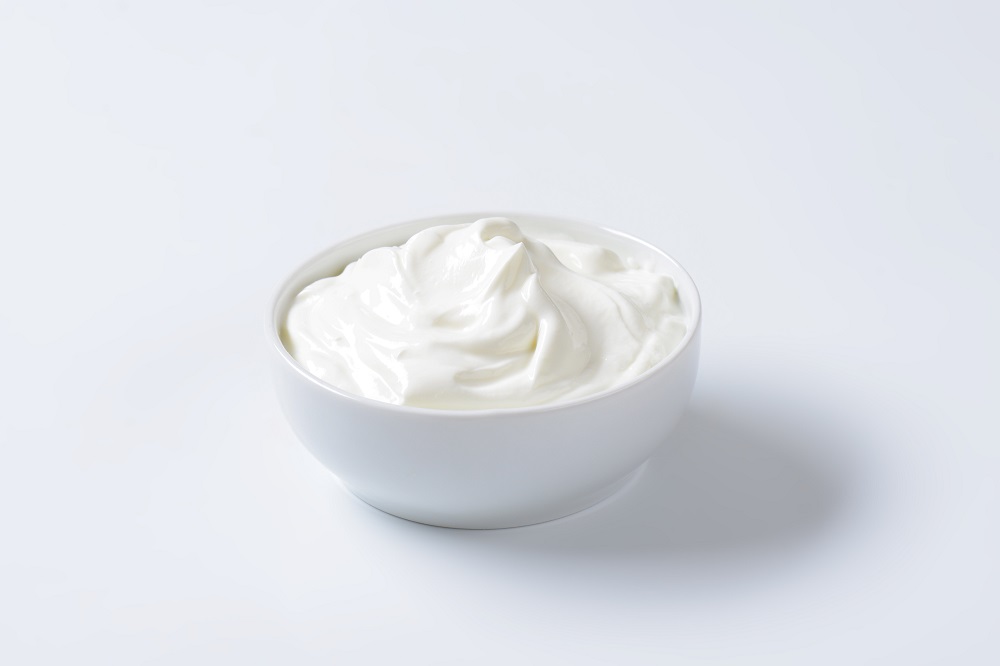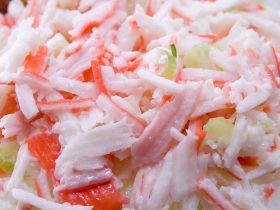Sour cream is a dairy product popular for pairing with bread or potatoes, or used atop soups, chilis and nachos. It is also increasing in popularity as a substitute for yogurts. In spite of its versatility and wide use in different dishes, is sour cream a type of dairy that is safe to eat while pregnant?
Sour cream is generally safe to consume during pregnancy, as long as it has been made from pasteurized ingredients. Most commercial brands are pasteurized and are safe. However, homemade sour cream can be made from raw milk and are, therefore, unsafe for pregnant women to eat.
Jesmarie Macapagal, RN, MD, DPPS
What is Sour Cream?
Sour cream, or soured cream as it is called in the UK, is the result of adding lactic acid-producing bacteria to regular milk cream. The result is a thick, rich and tangy cream that is used to make dips, creamy frosting, thicken sauces and garnish soups or baked potatoes. It can be added to soften baked goods, or added just before serving an already cooked dish.
Some prefer to make their own sour cream at home by combining heavy whipping cream and an acid like vinegar or lemon juice with some milk. But sour cream is also widely available in grocery stores, although some brands may contain additives and preservatives.

According to the US Food and Drug Administration (US FDA), sour cream contains a minimum of 18 percent milkfat. It can be eaten by itself or used as an ingredient.
Sour cream is ready to use straight from the container. It is popular as a garnish, condiment, raw dip, spread, sauce or frosting. It is sensitive to heat and will curdle when cooked, so it is often added at the end of cooking.
Pasteurized vs Unpasteurized Sour Cream
Pasteurization
More than a hundred years ago, the process of pasteurization was introduced (Lucey, 2015). It was developed by Louis Pasteur in 1864, and became an important procedure that renders milk safe for human consumption (Currier & Widness, 2018). It helped reduce the rates of illnesses associated with consumption of raw milk, and the prevalence of pathogenic organisms present in raw milk (Lucey, 2015).
Pasteurization is defined as “the process of heating every particle of milk or milk product, in properly designed and operated equipment, to any 1 of the specified pasteurization time/temperature combinations.” These procedures are intended to kill all viable human pathogens. The most common technique used is rapidly heating milk to a minimum of 72 degrees Celsius and maintaining that temperature for 15 seconds or more (Lucey, 2015).
It is important that all dairy to be consumed by pregnant women have undergone pasteurization. According to the requirements set by the FDA, all commercially manufactured sour cream in the US must be made from pasteurized milk.
Hence, commercially available sour cream is generally pasteurized and are safe to consume during pregnancy. Nevertheless, pregnant women must remain careful and look for the label that says “pasteurized” before purchasing from any store.
Unpasteurized Dairy
Choosing to eat homemade sour cream may be more dangerous because of the possible use of raw milk, which is not safe to consume during pregnancy. Farm-made versions and those sold directly from a ranch or from barn door sales should also be avoided because of the higher risk for cross-contamination and use of unpasteurized milk.
Raw milk and dairy products can harbor various microorganisms and can be key sources of food borne pathogens. These organisms can be present in milk due to direct contact with the contaminated farm environment or can be excreted from the udder of an infected animal (Oliver et al., 2005).
In 2015, Michel et al. demonstrated that Mycobacterium bovis is able to survive in fresh and soured milk for periods of time that can lead to exposure to people consuming these products. Unpasteurized milk and dairy products are popular components of household diets in rural, traditional livestock-owning communities in Southern Africa. Consumption of unpasteurized contaminated products in this area represent a source of exposure to Mycobacterium bovis, which is the causative agent of zoonotic tuberculosis in humans.
Pregnant women should avoid consuming unpasteurized milk and dairy products because of the potential risk of listeriosis. These can only be safely eaten when cooked or heated to 165 degrees Fahrenheit (or 74 degrees Celsius) (Taylor & Galanis, 2010).
Listeriosis
Listeriosis is a rare but severe food borne disease (Moran et al., 2018) caused by the bacterium Listeria monocytogenes, which has a predilection to infect immunocompromised individuals, the elderly, pregnant women and newborns. Pregnant women are particularly at risk and are considered 18 times more likely to be infected compared to the general population (Madjunkov et al., 2017).
Listeriosis during pregnancy is comprised of maternal, fetal and neonatal disease. Maternal illness commonly presents as mild fever with flu-like symptoms. Fetal listeriosis, on the other hand, has a high mortality rate of 25 to 35 percent. Neonatal disease can present as sepsis or meningitis with severe complications, and can also cause death with case fatality rate up to 20 percent (Madjunkov et al., 2017).
Listeriosis in pregnant women frequently affects the fetus and neonate via transplacental transmission (Lamont et al., 2011). It can result in serious complications, such as miscarriage, premature delivery, maternal and neonatal sepsis, and neonatal death. Cases of listeriosis during pregnancy were found to be more likely among women who consumed high-risk dairy products and other food sources that are known to have the potential for Listeria contamination (Moran et al., 2018).
Prevention remains the best method of controlling listeriosis and should be emphasized among pregnant women (Madjunkov et al., 2017). Recommendations to avoid listeriosis generally include avoiding the consumption of unpasteurized dairy products and the practice of good hygiene during food handling and preparation (Moran et al., 2018).
Tips on Sour Cream and/or Dairy Consumption During Pregnancy
According to the UK National Health Service (NHS), here are some information for healthier dairy choices during pregnancy:
- Dairy products are good sources of calcium and is important during pregnancy for fetal bone development.
- Pregnant women should choose low fat and low sugar varieties of dairy products.
- Some cheeses and dairy products should be avoided because they may cause harm and illness, which include brie, camembert, chèvre and Roquefort, unless they were used as part of a cooked dish.
- Cream is high in fat, so pregnant women should use it less often and only in small amounts.
- Only consume pasteurized milk and dairy products. These have been heat-treated to kill pathogenic microorganisms.
- Unpasteurized dairy can still be sold from farms and farmers’ markets, so make sure to check the label and ask before you purchase these food products.
Final Thoughts
Dairy foods are excellent sources of protein and calcium, and can be a great addition to a healthy and balanced diet of pregnant women. Sour cream is safe to consume during pregnancy, as long as it has undergone the process of pasteurization.
Unpasteurized sour cream, which can be homemade or farm-made varieties, may cause harm to an unborn fetus and should be avoided during pregnancy. Always check the label and look for the word “pasteurized”.
Confer with your physician to find out more about the best choices for dairy products that you can safely include in your pregnancy diet.
References
- https://www.thespruceeats.com/what-is-sour-cream-1808232
- https://www.healthline.com/nutrition/sour-cream-pregnancy
- https://www.accessdata.fda.gov/scripts/cdrh/cfdocs/cfcfr/CFRSearch.cfm?fr=131.160
- https://www.nhs.uk/live-well/eat-well/milk-and-dairy-nutrition/
- Currier, R., & Widness, J. (2018). A brief history of milk hygiene and its impact on infant mortality from 1875 to 1925 and implications for today: A review. Journal of Food Protection 81(10), 1713-1722. doi: 10.4315/0362-028X.JFP-18-186
- Lamont, R., Sobel, J., Mazaki-Tovi, S., Kusanovic, J. P., Vaisbuch, E., Kim, S. K., …, & Romero, R. (2011). Listeriosis in human pregnancy: A systematic review. Journal of Perinatal Medicine 39(3), 227-236. doi: 10.1515/jpm.2011.035
- Lucey, J. (2015). Raw milk consumption: Risks and benefits. Nutrition Today 50(4), 189-193. doi: 10.1097/NT.0000000000000108
- Madjunkov, M., Chaudhry, S., & Ito, S. (2017). Listeriosis during pregnancy. Archives of Gynecology and Obstetrics 296(2), 143-152. doi: 10.1007/s00404-017-4401-1
- Michel, A., Geoghegan, C., Hlokwe, T., Raseleka, K., Getz, W., & Marcotty, T. (2015). Longevity of Mycobacterium bovis in raw and traditional souring milk as a function of storage temperature and dose. PLOS ONE 10(6), e0129926. doi: 10.1371/journal.pone.0129926
- Moran, L. J., Verwiel, Y., Bahri Khomami, M., Roseboom, T. J., & Painter, R. C. (2018). Nutrition and listeriosis during pregnancy: A systematic review. Journal of Nutritional Science 7, e25. doi: 10.1017/jns.2018.16
- Oliver, S. P., Jayarao, B. M., & Almeida, R. A. (2005). Foodborne pathogens in milk and the dairy farm environment: Food safety and public health implications. Foodborne Pathogens and Disease 2(2), 115-129. doi: 10.1089/fpd.2005.2.115
- Taylor, M., & Galanis, E. (2010). Food safety during pregnancy. Canadian Family Physician 56(8), 750-751. https://www.ncbi.nlm.nih.gov/pmc/articles/PMC2920771/




